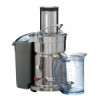Gastroback 40133 User Manual - Page 17
Fuit And Vegetable Facts
 |
View all Gastroback 40133 manuals
Add to My Manuals
Save this manual to your list of manuals |
Page 17 highlights
• All fruit and vegetables produce different amounts of liquids. This varies within the same group i.e. one batch of tomatoes can produce more juice than another batch. Since juice recipes are not exact, the precise quantities of any juice are not crucial to the success of a particular mixture. NOTE: To extract the maximum amount of juice always push the food pusher down slowly. Getting the right blend It is easy to create great tasting juice. If you have been making your own vegetable and fruit juices, then you know how simple it is to invent new combinations. Taste, colour, texture and ingredient preferences are a personal thing. Just think of some of your favourite flavours and foods - would they work well together or would they clash. Some strong flavours could over power the more subtle flavours of others. It is however, a good rule of thumb to combine starchy, pulpy ingredients with those high in moisture. Using the pulp The remaining pulp left after juicing fruit or vegetables is mostly fibre and cellulose which, like the juice, contains vital nutrients necessary for the daily diet and can be used in many ways. However, like the juice, pulp should be used that day to avoid loss of vitamins. Some of the uses of pulp are to bulk out rissoles, thicken casseroles or soups or in the case of fruit, simply placed in a bowl topped with meringue and baked for a simple dessert. Quite apart from the consumption use, pulp is great used in the garden for compost. NOTE: When using the pulp, there may be some pieces of fruit or vegetables remaining. These should be removed before using the pulp in any recipes. Fuit and vegetable facts Fruit and vegetables Apples Apricots Banana Best season to buy Autumn/ Winter Summer Spring Storage Vented plastic bags in refrigerator Unwrapped in crisper of refrigerator Cool, dry place Beetroot Winter Blueberries Summer Broccoli Autumn/ Winter Cut off tops, then refrigerate unwrapped Cover in the refrigerator Plastic bag in refrigerator Brussels Sprouts Autumn/ Winter Unwrapped in crisper of refrigerator Nutritional value Kilojoule/calorie count High in Dietary Fibre and Vitamin C High in Dietary Fibre, Potassium Dietary Fibre, Potassium, Vitamin C, B6 Good source of Folate, Dietary Fibre, Vitamin C, Potassium 100 g Apple = 218 kj (52 kcals) 100 g Apricot = 226 kj (54 kcals) 100 g Bananas = 377 kj (90kcals) 100 g Beetroot = 190 kj (45 kcals) Vitamin C Vitamin C, B2, B5, B6, E, Folate, Dietary Fibre Vitamin C, B2, B6, E, Folate, Dietary Fibre 100 g Blueberries = 201 kj (48 kcals) 100 g Broccoli = 110 kj (26 kcals) 100 g Brussels Sprouts = 151 kj (36 kcals) 47















